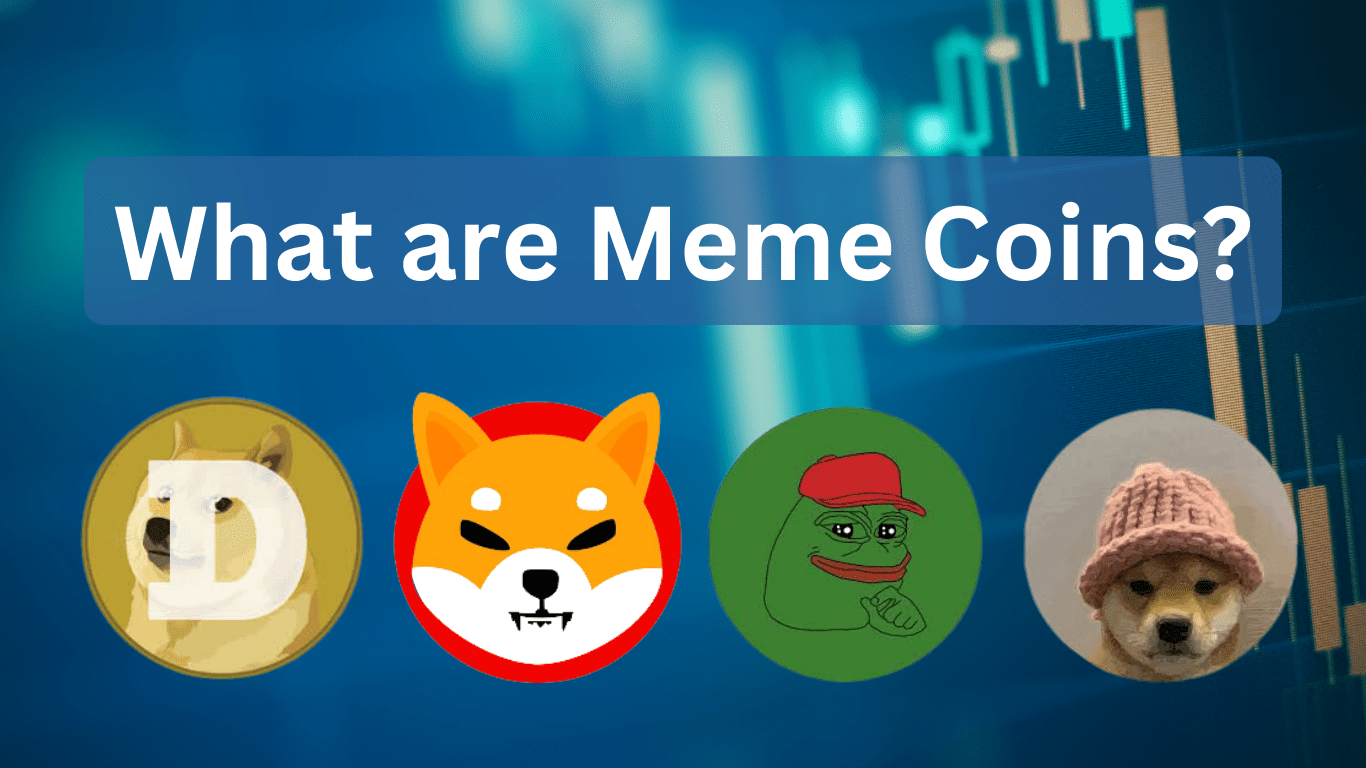Meme coins are a popular type of cryptocurrency, with individual coins and tokens being inspired by internet memes or pop culture references. They are often humorous in nature, have very little utility and a low value per token.
Despite their popularity, meme coins are an incredibly risky investment, even compared to an already volatile asset class. With this in mind, it’s important to learn as much as possible about meme coins before deciding to commit real money to a trade.
Please note: We do not review meme coins at Altcoin Analyst.
What Makes a Meme Coin?
It is usually relatively easy to know whether a cryptocurrency is considered a meme coin or not. Compared to other cryptocurrencies, which are usually created with the intention of changing industries or benefitting users, meme coins are more typically concerned with fun, community and internet humour.
Here are some of the key features of a meme coin:
- Based on a Meme/Humour: Memes are the foundation of any meme coin, with these cryptocurrencies often drawing inspiration from popular internet jokes, animals or viral trends.
- Community/Social Following: Meme coins continue to thrive because of their strong online communities, with followers gathering on social media platforms such as X (Twitter) and Reddit to create hype and promote the currency in question. Usually, the more people talking about the meme coin, the better its price performance.
- Lack of Utility: Unlike most cryptocurrencies, which aim to solve real-world problems, meme coins do not generally have a specific purpose. Instead, meme coins are designed for virality, community and trading.
- High Volatility: Meme coins are known for their wild price swings, with their value often skyrocketing or crashing within a short period of time; it is rare to see sustained price increases, making them an incredibly risky proposition for investors.
- Low Token Value: Meme coins usually have a very large maximum supply – or even an infinite number – of tokens. This means that individual tokens are often priced very cheaply, typically at a very small fraction of a cent. This low price point makes meme coins very accessible to beginner investors but also contributes to their high volatility.
How Do Meme Coins Work?
Despite their lighthearted nature, meme coins function using blockchain technology, in much the same way as other cryptocurrencies do. Blockchain technology allows for the tracking of ownership and the monitoring of transactions, ensures transparency and eliminates the need for a centralised authority or third-party intermediaries to be involved.
Meme coins are created by developers, who launch them on existing blockchains such as Ethereum (ETH) or Solana (SOL). Developers will determine the total supply of coins and how tokens will be distributed.
Post-launch, meme coins can be traded on cryptocurrency exchanges, where investors are able to buy and sell them like any other cryptocurrency. However, meme coins are usually only listed on large exchanges once they have gained some mainstream attention. Until this point, traders and investors will need to use a decentralised exchange (DEX) in order to purchase any meme coins that they’re interested in.
Why Do People Buy Meme Coins?
Considering how inherently risky they are, it might seem strange that anybody would want to start investing in meme coins. They often lack real-world utility and it’s impossible to know whether they will increase in value.
However, there are many reasons that somebody might want to invest in meme coins. Meme coins are generally best suited to investors with a high risk tolerance, as they have a very high-risk, high-reward potential. Although all cryptocurrencies are a gamble, in some regard, meme coins offer considerable volatility and can regularly experience drastic price movements in a matter of hours or days. While risky, many investors are attracted to the potentially explosive returns associated with meme coins.
Some investors are also drawn to certain meme coins because of the power of community. The communities behind meme coins are often filled with a level of camaraderie, which might appeal to certain individuals. The “Fear of Missing Out” (FOMO) is also a contributing factor, with social media being used to generate hype and create a frenzy of excitement, which some investors will want to be a part of.
Benefits of Meme Coins
While meme coins are a more risky investment than other cryptocurrencies, or other asset classes, there are some advantages to consider.
- Entry Point to Crypto: With a low individual token value, meme coins can be a relatively cheap option for new investors looking to gain exposure to the cryptocurrency market. As mentioned above, with new meme coins often only being available on decentralised exchanges, they can also provide an avenue into decentralised finance (DeFi) for interested investors.
- Diversifying a Portfolio: Meme coins can also be a good option for investors looking to diversify their cryptocurrency portfolio. Many experienced investors will attribute a small percentage of their capital to meme coin positions, in the hopes of taking advantage of their volatility. Meme coins also often move differently to the wider cryptocurrency market and so could be used as a hedge against negative bitcoin (BTC) price movements.
- Volatility: Although the volatility associated with meme coins is their riskiest feature, it can also provide opportunities for impressive returns. Assuming everything goes your way, it can be possible to make significant gains with a relatively small amount of capital. However, there is no guarantee of this happening, and so investors should never invest more into meme coins than they can afford to lose.
Risks of Meme Coins
Although there can be huge potential for returns within the meme coin sector, the risks cannot be understated. As a result, it’s essential that investors do their own research before committing any money to a meme coin trade.
- High Volatility: Meme coins are notorious for their wild price swings and their value can surge based on a social media trend or celebrity endorsement, but it can also plummet just as quickly. This volatility makes them a risky investment and means that investors could easily lose a significant portion of their money in an incredibly short period of time.
- Pump-and-Dump Schemes: Cryptocurrency is a largely unregulated asset class anyway, but meme coins are even more susceptible to pump-and-dump schemes than most crypto assets. In these scams, a group will artificially inflate the price of a meme coin through hype and social media manipulation, and then will sell their holdings before the price crashes, leading to heavy losses for any remaining investors.
- Lack of Utility: Unlike established cryptocurrencies that aim to solve real-world problems, most meme coins have no underlying purpose or use case. Instead, the value of a meme coin is purely speculative, and so there is no guarantee that they will maintain their value in the long-run.
- Rug Pulls: Rug pulls are much more prevalent when it comes to meme coins specifically. A rug pull involves the developers of a cryptocurrency project abandoning it after raising money from investors, leaving them with worthless coins.
- Security Risks: Meme coins often trade on smaller, less-established cryptocurrency exchanges, which often have less liquidity than larger centralised exchanges. These exchanges may also be more vulnerable to hacking and security breaches, and so are naturally more risky.
The History of Meme Coins
Meme coins actually date back to the very early days of cryptocurrency, but it wasn’t until 2013 and the launch of Dogecoin (DOGE) that the idea gained mainstream attention. Created as a joke by Billy Markus and Jackson Palmer, DOGE utilised the popular Shiba Inu “Doge” meme and quickly caught the intention of cryptocurrency investors. Despite its lack of utility, Dogecoin actually has very low transaction fees and fast block times, leading to increased adoption amongst investors.
In 2019, Elon Musk tweeted in support of Dogecoin, leading to the cryptocurrency experiencing an impressive price growth in a very short space of time.
Dogecoin’s success saw the creation of copycat meme coins, often featuring other dog breeds or internet references. For example, Shiba Inu (SHIB), Floki Inu (FLOKI) and Dogelon Mars (ELON) all leverage similar themes and have experienced their own successes following Dogecoin’s meteoric growth.
What Are The Most Popular Meme Coins?
There are hundreds of meme coins in existence, with new tokens being created on a daily basis. However, only a few meme coins have gained true notoriety and experienced real mainstream success and wider adoption.
NOTE: We do not endorse any of these coins as investments!!
Dogecoin (DOGE)
Created in 2013, Dogecoin was created as a light-hearted joke. It features the popular “Doge” meme and gained rapid popularity online. DOGE is a community-driven cryptocurrency that has actually experienced significant real-world adoption since its launch. In fact, in 2021, Dogecoin became one of the ten largest cryptocurrencies by market capitalisation.
Dogecoin operates on its own Proof of Work (PoW) blockchain, although it actually uses less energy than the Bitcoin blockchain does. Dogecoin also has an inflationary supply, meaning that more DOGE coins are continuously created. DOGE transactions are relatively fast and cost-effective, meaning that the cryptocurrency has become a popular choice for micropayments and day-to-day transactions.
Shiba Inu (SHIB)
Shiba Inu (SHIB) is an ERC-20 token built on top of the Ethereum blockchain, meaning that the Shiba Inu network benefits from Ethereum’s security and has access to a range of decentralised applications (dApps).
The Shiba Inu network is a multi-token ecosystem that includes SHIB, LEASH, BONE and TREAT tokens. However, SHIB is the main token within this ecosystem and is used for staking and transactions.
Although most meme coins have limited-to-no utility, there are actually a number of crypto projects built around Shiba Inu, including:
Shibaswap: A decentralised exchange
Shibarium: A Layer 2 scaling solution for Ethereum
Shiba Eternity: A Web3 play-to-earn game
Shib.io: A Shiba Inu-based metaverse
Pepe (PEPE)
Pepe (PEPE) is a newer meme coin that has recently experienced impressive growth. Built on Ethereum, PEPE is an ERC-20 token inspired by the popular “Pepe the Frog” meme. PEPE is a utility meme coin that is used within the Pepe ecosystem both as a means of exchange and also of governance. It is a Proof of Stake (PoS) token that allows investors to stake their PEPE tokens in order to contribute to the network’s stability and security.
PEPE went viral in 2023, witnessing staggering gains and experiencing a number of high-volume transactions in a short period of time.
PEPE is a deflationary meme coin, meaning that a small percentage of tokens are burned with each transaction that takes place. This mechanism is designed to create increasing scarcity and potentially drive up the value of the remaining PEPE tokens.

Summary
Meme coins are very popular with cryptocurrency investors. They provide the potential for significant gains but should always be treated with caution. High volatility and limited use cases mean that it is possible for investors to lose money quickly, and so it is more important than ever that interested parties conduct thorough research before committing real money to any meme coin trades.
FAQs
What should you look for in a meme coin?
Primarily, investors should look for meme coins with a strong community as this is a fundamental part of their success. Meme coins are also very trend-focused, with certain memes or references performing well at different times. For example, once PEPE saw significant growth, a host of other frog-related coins followed suit.
Additionally, different blockchains have historically experienced greater levels of interest at different points in time. For example, in late 2023 and early 2024, Solana-based meme coins grew in popularity compared to Ethereum-based meme coins. As a result, it’s a good idea to keep an eye out for different trends if you’re hoping to invest in meme coins.
Are meme coins safe?
Meme coins are generally considered to be one of the least safe investments available. Thanks to high volatility, a lack of utility and malicious players engaging in pump-and-dump schemes and rug pulls, meme coins are incredibly risky. If you are going to invest in meme coins, you should assume that you will lose all of your capital.
Do meme coins have a future?
Yes, it is likely that meme coins will have a future for as long as the wider cryptocurrency market continues to see increased adoption. More businesses are accepting meme coins as currency and newer meme coins are being created with increased utility compared to the original, early meme coins.
Also, for as long as there is potential for money to be made, it is likely that investors will continue to show interest in the meme coin market, regardless of the risks attached to it.



